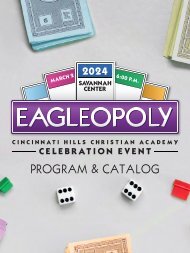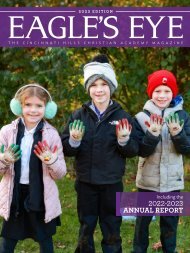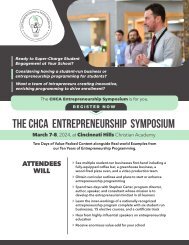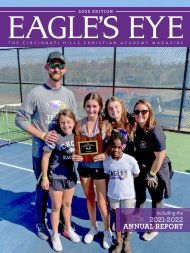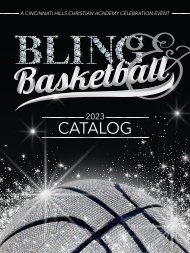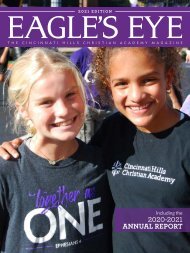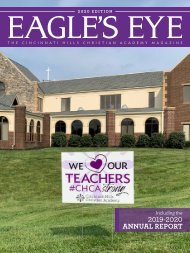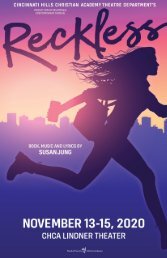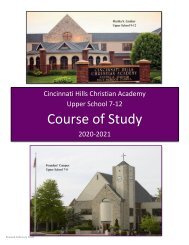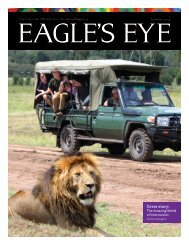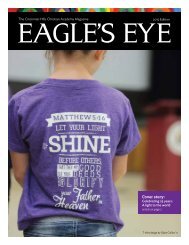Mission, Vision, Competencies, Standards, and Benchmarks
A Statement of Curriculum CINCINNATI HILLS CHRISTIAN ACADEMY Edyth B. Lindner Campus Otto Armleder Memorial Education Center Founders’ Campus Martha S. Lindner Campus 2019 Edition
A Statement of Curriculum
CINCINNATI HILLS CHRISTIAN ACADEMY
Edyth B. Lindner Campus
Otto Armleder Memorial Education Center
Founders’ Campus
Martha S. Lindner Campus
2019 Edition
You also want an ePaper? Increase the reach of your titles
YUMPU automatically turns print PDFs into web optimized ePapers that Google loves.
‣ Apply scientific ideas, principles, <strong>and</strong>/or evidence to construct, revise, <strong>and</strong>/or use an<br />
explanation for real-world phenomena.<br />
‣ Identify the evidence that supports particular points in an explanation, <strong>and</strong> apply<br />
scientific reasoning to show why the data or evidence is adequate for the explanation<br />
or conclusion.<br />
‣ Generate <strong>and</strong> compare multiple possible solutions to a problem based on how well<br />
each is likely to meet the criteria <strong>and</strong> constraints of the problem.<br />
Essential Questions:<br />
‣ How could we use science <strong>and</strong> engineering to create a better world?<br />
‣ How could we use science <strong>and</strong> engineering to ensure <strong>and</strong> sustain enough food, water<br />
<strong>and</strong> resources for global community?<br />
Competency: Obtaining, evaluating, <strong>and</strong> communicating information<br />
Description:<br />
Scientists <strong>and</strong> engineers must be able to communicate clearly <strong>and</strong> argue persuasively, using<br />
data to support their claims. Critiquing <strong>and</strong> communicating ideas individually <strong>and</strong> in groups is<br />
a critical professional activity. Students will learn to…<br />
‣ Compare <strong>and</strong> critique two arguments on the same topic <strong>and</strong> analyze whether they<br />
emphasize similar or different evidence <strong>and</strong>/or interpretations of facts.<br />
‣ Respectfully provide <strong>and</strong> receive critiques about one’s explanations, procedures,<br />
models, <strong>and</strong> questions by using relevant evidence <strong>and</strong> posing <strong>and</strong> responding to<br />
questions that elicit pertinent elaboration <strong>and</strong> detail.<br />
‣ Construct, use, <strong>and</strong>/or present an oral <strong>and</strong> written argument supported by empirical<br />
evidence <strong>and</strong> scientific reasoning to support or refute an explanation or a model for a<br />
phenomenon or a solution to a problem.<br />
‣ Use data to evaluate claims about cause <strong>and</strong> effect.<br />
‣ Critically read scientific texts adapted for classroom use to determine the central ideas<br />
<strong>and</strong>/or obtain scientific <strong>and</strong>/or technical information to describe patterns in <strong>and</strong>/or<br />
evidence about the natural <strong>and</strong> designed world(s).<br />
‣ Integrate qualitative <strong>and</strong>/or quantitative scientific <strong>and</strong>/or technical information in written<br />
text with that contained in media <strong>and</strong> visual displays to clarify claims <strong>and</strong> findings.<br />
‣ Evaluate competing design solutions based on jointly developed <strong>and</strong> agreed-upon<br />
design criteria.<br />
‣ Communicate scientific <strong>and</strong>/or technical information in writing <strong>and</strong>/or through oral<br />
presentations, including various forms of media as well as tables, diagrams, <strong>and</strong><br />
charts<br />
Essential Questions:<br />
‣ How do we make predictions for the future <strong>and</strong> ensure that they have validity?<br />
‣ How do pictures, graphs, tables <strong>and</strong> data “paint a thous<strong>and</strong> words”?<br />
‣ How do we merge or resolve new discoveries with our current underst<strong>and</strong>ing?<br />
Back to Table of Contents




